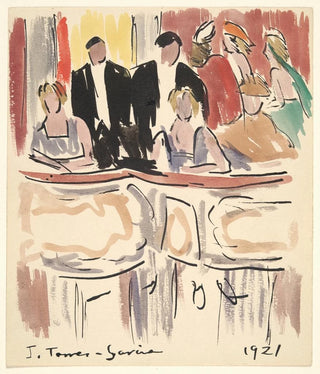Art print | Les artistes accueillent les spectateurs dans les loges du théâtre - Joaquín Torres-García


View from behind

Frame (optional)
In a world where art and spectacle meet, the artwork "The artists welcome the spectators in the theater boxes" by Joaquín Torres-García stands out for its ability to capture the essence of the theatrical scene. This piece, a true invitation to enter the universe of artists, evokes the magic of the boxes—those spaces rich in history where intimacy of preparations and the excitement of performance intertwine. Through this depiction, Torres-García does not merely portray a scene; he creates a dialogue between the artist and the viewer, an exchange that transcends the simple act of watching.
Style and uniqueness of the artwork
Torres-García's style is characterized by a geometric and symbolic approach, blending elements of cubism with a sensibility unique to Latin American art. In "The artists welcome the spectators in the theater boxes," the forms are stylized, the colors vibrant, and the lines dynamic. The artist manages to establish an atmosphere that is both festive and contemplative, where each character seems to play a role in a larger scene. The boxes, as meeting places, become a microcosm of society, where iconic figures of the artistic world coexist. This artwork is not limited to depicting a scene; it also evokes the emotions and tensions that inhabit it, paying homage to the complexity of the theatrical experience.
The artist and his influence
Joaquín Torres-García, a prominent figure of modern art, knew how to leave his mark on his era through a bold exploration of forms and meanings. Born in Uruguay in 1874, he spent part of his life in Europe, where he was influenced by avant-garde movements while developing a unique style. His commitment to art as a means of social and cultural expression left an indelible imprint on his contemporaries and future generations. By integrating elements of Latin American culture into his works, he managed to create a bridge between the old and the modern, between Europe and America. "The artists welcome"

Matte finish

View from behind

Frame (optional)
In a world where art and spectacle meet, the artwork "The artists welcome the spectators in the theater boxes" by Joaquín Torres-García stands out for its ability to capture the essence of the theatrical scene. This piece, a true invitation to enter the universe of artists, evokes the magic of the boxes—those spaces rich in history where intimacy of preparations and the excitement of performance intertwine. Through this depiction, Torres-García does not merely portray a scene; he creates a dialogue between the artist and the viewer, an exchange that transcends the simple act of watching.
Style and uniqueness of the artwork
Torres-García's style is characterized by a geometric and symbolic approach, blending elements of cubism with a sensibility unique to Latin American art. In "The artists welcome the spectators in the theater boxes," the forms are stylized, the colors vibrant, and the lines dynamic. The artist manages to establish an atmosphere that is both festive and contemplative, where each character seems to play a role in a larger scene. The boxes, as meeting places, become a microcosm of society, where iconic figures of the artistic world coexist. This artwork is not limited to depicting a scene; it also evokes the emotions and tensions that inhabit it, paying homage to the complexity of the theatrical experience.
The artist and his influence
Joaquín Torres-García, a prominent figure of modern art, knew how to leave his mark on his era through a bold exploration of forms and meanings. Born in Uruguay in 1874, he spent part of his life in Europe, where he was influenced by avant-garde movements while developing a unique style. His commitment to art as a means of social and cultural expression left an indelible imprint on his contemporaries and future generations. By integrating elements of Latin American culture into his works, he managed to create a bridge between the old and the modern, between Europe and America. "The artists welcome"






